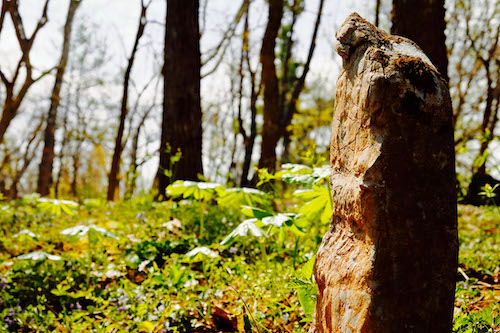By: Gabrielle Sanderson
Sarah Kohrs, a Northern Shenandoah Extension Master Gardener, attended a workshop for the Corhaven Slave Cemetery called “Honoring the Forgotten” and immediately jumped on the opportunity to apply for the Corhaven Graveyard to become a project through the Extension Northern Shenandoah Valley Master Gardeners. The mission of the Extension Master Gardener Program is to share knowledge and empower communities, and through the Corhaven Graveyard project, Northern Shenandoah Master Gardeners illustrate the power of this mission.
The original name of the slave graveyard, the Sam Moore Slave Cemetery, named for local slave owner Sam Moore, stems from a historical study from Duane Lyle Borden’s Tombstone Inscriptions of Shenandoah County and Bordering Counties in 1984. Today, the Corhaven Graveyard is one of only three acknowledged and found slave cemeteries in Shenandoah county. The Corhaven Graveyard matches descriptions of slave cemeteries as described by Dr. Lynn Rainville, who is an anthropological archaeologist studying the everyday life of ordinary people in the past, in her publication Hidden History: African American Cemeteries in Central Virginia. Some of the characteristics are field gravestone markers, a high elevation, distance from a manor house, along a fence line with water nearby, and certain animals.
One characteristic that first got Kohrs thinking that Extension Master Gardeners could help with this important restoration project at Corhaven Graveyard is that plants were often integrated into slave cemeteries to be used as grave markers. “According to several resources, I learned that native perennials and trees were often used as memorial markers in slave cemeteries, since writing on the fieldstones (if there were any) was nonexistent due to laws prohibiting literacy among the enslaved,” mentions Kohrs.
After clearing out debris surrounding the stones, Northern Shenandoah Master Gardeners studied the perennials found at the Corhaven Graveyard to determine whether the site held any intentional plantings. They discovered that the burial ground already had an abundance of pale violets and a 200-year-old grape vine. In order to preserve the site and restore how it may have looked in the mid 1800s, Extension Master Gardeners proceeded to incorporate a multitude of other native perennials historically found in slave cemeteries. For example, native redbuds, ferns, and spicebushes were planted for erosion control within the graveyard.
Members of the Corhaven Graveyard committee was interested in creating a tribute garden space to welcome visitors to the site. “By creating a space that serves the purpose of a foyer people can learn from an information kiosk, explore native perennials and plants often gleaned by those enslaved on plantation,” explains Kohrs. “We’ve added yucca in the tribute space; in July regal spires jut up from these shrubs and, traditionally, they are common features in African American cemeteries.”
In addition to preserving an important part of American history, the graveyard also plays host to a variety of hands-on educational opportunities and chances for collaboration among different groups. Recently, the EMG program worked hand-in-hand with a local Girl Scout Troop by helping to maintain the plants in the progressively changing tribute garden space and by creating a monarch garden way station. “We have incorporated native perennials typical for a monarch way station, from creeping phlox to menarada, boneset to tansy to rudbeckia,” states Kohrs. Through this the Extension Master Gardener volunteers were able to help educate the girls about the importance of choosing native perennials.
“Some groups just want information, so we are in the process of creating a web feature on corhavengraveyard.org that describes the plants in the tribute garden and burial grounds,” states Kohrs. “Visitors will be able to use their phones to follow Quick Response (QR) codes to specific webpages that connect them with more information on the plants, as well as any information the EMG program offers regarding planting guides for those plants.” Whether they are educating about best gardening practices, helping with erosion control in a riparian buffer zone, or just contributing to a positive community project, the Extension Master Gardeners are interacting with the community around them to care for a historically significant site.
According to Kohrs, one Extension Master Gardener that worked on the project stated, “I feel like this is one of the most meaningful projects the Northern Shenandoah Master Gardeners have ever taken part in. Congratulations on all your hard effort and getting so many groups and individuals involved.”
“That’s what is so meaningful about the project,” says Kohrs. “We are finding a unique and compassionate way to connect with the community. It’s an ‘out-of-the-box’ kind of project that strives to touch the lives of others and weave together a wide variety of non-profits, individuals, and other community groups in an empathetic way.”

